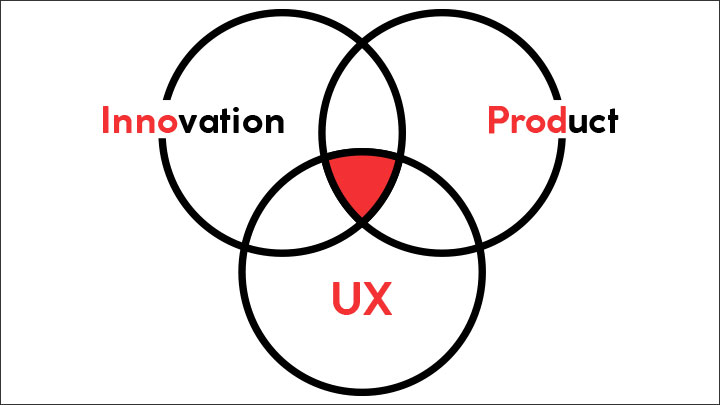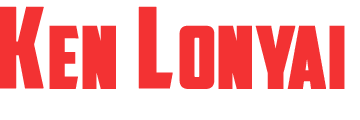
InnoProdUX – Innovation, Product Management, and UX
InnoProdUX™ is the framework for you to thrive at getting your products to market.
InnoProdUX™ is the nexus that describes both me and the three most important aspects of a product org: innovation, product management, and UX.
There’s so much clear overlap between these three elements that it’s hard to believe I had to be the one to formalize this rationale, to coin this term, and create a dialog around it. The model should have existed and been embraced decades ago. Look at the diagram above: the energy is in the convergence area. Still, the diagram doesn’t really express the true amount of intersection and its rich potential. The intersection is really larger and three dimensional and that’s the point. So think of that nexus as the “atomic core” of this powerful product-focused trifecta.
InnoProdUX™ is foremost, an ideology, a state of mind, and an approach to reframe the core aspects of the product process, to create better, more desirable products.
InnoProdUX™ encompasses specific practices, yet it’s a flexible methodology that is not limited by discreet boundaries. InnoProdUX™ is the intrinsic truth that these three factors are definitively required—emphasis on required, to create valuable products that users adore.
To design/build the best products, please remove compartmentalization of these three practices from your thinking. That’s only necessary for the utilization of expertise and division of labor across the complexity of the product development process. From a product visioning frame of mind and a user-needs solutioning approach, even though it’s standard practice, segmenting these contributing elements into distinct job responsibilities is not ideal.
For the InnoProdUX™ philosophy and the positive results it brings, the sum of the whole is greater than the sum of the parts, so keep your thinking around these processes united and the outcomes you produce will be superior products and more delighted customers. It’s precisely what makes my product work successful.
Still want to know why these elements?
Innovation
There is ALWAYS a need to innovate. It can be an entirely new product, a feature, a process, a pricing model, a distribution change, or other aspect, but there is no true product org without innovation.
Sometimes innovation is considered a nice-to-have that gets lost in the day-to-day effort to get features built and to maintain a working product. “Lack of budget” or “it’s a luxury” are common excuses to dismiss innovation thinking and implementation. Those diversions are manifestly wrong.
Innovation is imperative. In a digital world, the axiom “if you’re standing still, you’re falling behind” is absolutely a fact. There’s a difference between a full-on R&D program which typically requires “big” resource commitments that a company isn’t necessarily positioned for and maintaining or clawing out some level of continuous innovation as part of the product process. It can be small and still be innovation.
And…
Who came up with the idea that innovation is an expense? The idea that it’s a nice to have? Innovation properly managed and vetted is an investment that will pay dividends in revenue, retention, goodwill, word-of-mouth, and more, even in bad economic times when one of the first cuts is to innovation.
Some products are viewed as commodities that are unimprovable or brand icons that can’t be tampered with. Both extremes suffer from the “there’s nothing there,” “that’s the way we’ve always done it,” or “we don’t want to mess with a good thing” mentalities, which are the innovation blind spots that competitors seize upon to gain market traction. I guarantee both of these product categories [all product categories] constantly have room for innovation.
Dismissing innovation is a recipe for disaster.
That’s why I’m always thinking from an innovative mindset, even when I’m working on core product features/functionality. It’s crucial to be open to innovation and find opportunities in even the smallest things, including process. I can’t help but think that way. If you don’t, it’s time to get started.
Product Management
This is the core effort to transform ideas into meaningful things. Without delving into all the product management processes [ask Inno about them], this discipline brings together user needs and market opportunity with all the stakeholders and stakeholder orgs across a company.
Product management is truly where all the plates are kept spinning at all times to create and maintain products and a viable offering in the market. That’s in no way minimizing all the critical adjacent teams, contributors, supporters, and advocates for product, but no other function brings them together as does product management.
Building products without a product team is certainly possible, but it’s a challenge to be avoided. Engineers and designers can get some rough concepts and/or directives and create products, but it’s the product manager and support roles such as business analysts or product owners that assemble the process and focus on product producing methods, resulting in viable products that customers want and delight in.
UX
I view UX as a measure of the temperature for success. It’s the mechanism that makes a product worthwhile or not. It represents the take-away that every user has when interacting with a product [or service]. When UX is reduced to a single word definition, that word is “delight.” Therefore, UX design is the path to delight or the lack thereof.
The first words of this site are “Everything in life is an Experience.” That includes what your product delivers for users. If users are delighted, the product has value—and customers buy happiness, fulfillment, and value more than anything else.
Making UX a centerpiece of product design is blatantly obvious. The challenge is the separation of most of the UX process from product management. Typically, product managers play a role in UX, but kind of at arm’s length, because UX is in the design wing of a company and almost always reports to different leadership than product. That gap is where trouble can arise.
UX really needs to be led, defined, managed, and monitored by the product manager/org. Not necessarily in detail, not directly, not in conflict/competition with design leadership, but actively from the start of any product ideation through delivery and follow-up feedback. Effectively, for product development, UX “works for” product, so this approach and integration is logical, necessary, and a keystone of the practice of InnoProdUX™.
The last and in some ways most important aspect of UX is that it is the one InnoProdUX™ contributor that is measurable both qualitatively and quantitatively. UX is where prospects make the decision to become customers and customers make the decision to stay customers. Those decisions are where a company makes its money. It’s the core of a theorem you must learn called the UX-CX Profitability Continuum.
The UX-CX Profitability Continuum clearly demonstrates that the way to sustained profits is to focus on the best UX. Do so and profits will follow. Any other “strategy” will kill profits and potentially the company.
